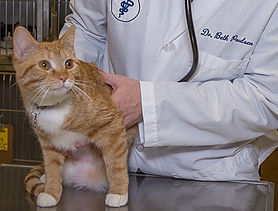Feline upper respiratory infections are a common cause of nasal congestion, sneezing and ocular discharge in cats. Occasionally these cats will have more severe symptoms like a fever, cough, and decreased appetite as the infection progresses.
Causes of feline respiratory infections are primarily viruses. The most common viruses implicated are herpesvirus and calicivirus. Secondary bacterial invaders will take advantage of the weakened immune system resulting in worsening of the symptoms. Cats contract these viruses and bacteria by other infected cats. Most commonly this occurs in cats recently adopted from shelters or rescue groups, after boarding, or in cats that spend time outdoors or those that have contact with cats who spend time outdoors. These viruses are highly contagious and once infected, a cat can shed the virus intermittently throughout their lives. Stress can cause recrudescence (flare up) of a previously contracted respiratory virus.
Diagnosis is made by physical exam and history. In complicated cases radiographs, blood panels or viral testing may be warranted.
Treatment is often based on the severity of clinical signs but may include one or more of the following:
- Warm humid air therapy (spending time in bathroom when a hot shower is running, or having a warm air humidifier nearby) This can help reduce nasal congestion
- Antibiotics if there is indication of a secondary bacterial infection
- Medicated eye drops/ointment
- Fluids may be given under the skin if dehydration is suspected
- Warming canned food can help encourage a better appetite
Infected cats should be kept indoors to monitor clinical signs and response to treatment.
Most feline respiratory infections run their course in 10-14 days, however cats can remain infectious for months. It is important to keep in mind that once infected cats may have

